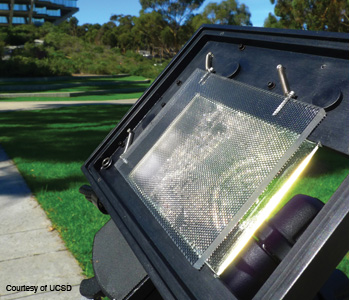 Researchers at the University of California, San Diego, have designed a planar solar concentrator with millimeter-sized lenses that focus sunlight onto a 1-mm-thick glass waveguide. Collected sunlight emits out the waveguide edge, and the system follows the sun's position using a novel tracking platform (the black frame).
Researchers at the University of California, San Diego, have designed a planar solar concentrator with millimeter-sized lenses that focus sunlight onto a 1-mm-thick glass waveguide. Collected sunlight emits out the waveguide edge, and the system follows the sun's position using a novel tracking platform (the black frame).
The sun beats down on the American Southwest with a vengeance. In fact, the arid desert region covering much of the western United States receives some of the highest annual direct normal irradiance—the amount of energy from the sun in the direct beam (the sunlight that casts a shadow) per unit area—in the world.
Politicians, scientists, businesses and citizens are hungry to make use of this free, renewable and powerful source of energy, and not just in the Southwest. Photovoltaic technology is in demand everywhere the sun shines (and even where it doesn't). Although the high cost is still inhibiting widespread use, that is starting to change. And one promising piece of the puzzle happens to involve optics—concentrated photovoltaic (CPV) technology.
A solar concentrator is essentially a light bucket that focuses sunlight onto a small area. A CPV system incorporates solar concentrator components such as lenses, mirrors or other optics to collect incoming sunlight and focus it efficiently onto a photovoltaic cell array, which then converts sunlight into useable, storable energy. Innumerable systems that feature CPV technology are either on the market or in development. Over 50 companies offer commercial solar concentrator technology around the world; a smattering of them are Amonix (Seal Beach, Calif., U.S.A.), CompSolar (Hsinchu Science Park, Taiwan), Concentrix Solar (Freiburg, Germany), Guascar Photon (Biscay, Spain), Opel International (Shelton, Conn., U.S.A.), Silicon CPV (Essex, England) and SolFocus (Mountain View, Calif., U.S.A.). In September this year, JDSU (Milpitas, Calif., U.S.A.) announced that it is entering the market as a supplier of CPV cells.
Concentrated photovoltaic technology has been evolving as a market since the 1970s, but it has only recently become commercially viable compared to crystalline silicon (c-Si) solar cells (which comprise approximately 75 percent of the market) and thin-film photovoltaic (TF-PV) cells. Although it would seem easy enough to put a lens in front of a solar cell (much like you might ignite a leaf with a magnifying glass), the primary barrier to contractor technology has been the difficulty of making a system that is effective at delivering the light to the cell, keeping the cell cool and achieving a design that works reliably for years.
The "active ingredients" in photovoltaic cells—crystalline silicon and other III-V semiconductor materials such as germanium (Ge) and gallium-arsenide (GaAs)—have historically been very expensive. Incremental improvements in PV cell efficiency and the optimization of other parts of the system such as concentrating optics and tracking systems are finally making the cost of CPV systems competitive.
Two main types of CPV systems are in use today: refractive types that use Fresnel lenses or similar refractive optics, and reflective systems that use one or more mirrors. Regardless of the optics, the main benefit of concentrating sunlight at the face of the photovoltaic cell is to decrease the amount of expensive photovoltaic material required. The cost of c-Si has been reduced a lot by major Chinese manufacturers and is now competitive with TF-PV. However, the solar cell can be as much as 75 percent of the cost of the CPV module.
Steel, acrylic and glass are inexpensive compared to photovoltaic cells, so concentrators can reduce the material cost of a CPV system. Also, because CPV products can generate the same amount of energy using smaller solar cells, the cells are often high efficiency; if appropriately designed, a high-efficiency CPV system will require less real estate to generate a kW of power.
The second benefit of concentrator systems is manufacturability and reliability. While the technology is young in terms of commercial deployment, concentrator systems use inexpensive durable materials that have been manufactured for decades in well-established industries such as in the automotive sector and the semiconductor market. Seals, coatings, glass and aluminum are less susceptible to supply constraints like that of the specialized materials in PV cells. So use of the more common materials can reduce the amount of PV material in a system and therefore ease supply headaches. Materials like glass and aluminum are also more easily and quickly scalable to high-volume production, and industry standards for testing and qualification are also well established for them.
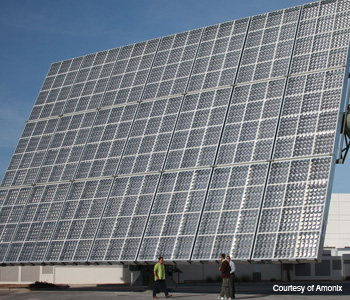 The Amonix manufacturing facility in North Las Vegas, Nev., U.S.A., opening in 2011, will feature the green power of their Fresnel-based multijunction solar-cell CPV technology.
The Amonix manufacturing facility in North Las Vegas, Nev., U.S.A., opening in 2011, will feature the green power of their Fresnel-based multijunction solar-cell CPV technology.
The magnification categories of CPV technology are divided into three classes of systems: low concentration of less than 10× magnification of sunlight; medium concentration of between 10× and 100×; and high concentration of 100× to 1,000×. In terms of the number of companies and total investment, the development of high-concentration systems is ahead of low-concentration systems, according to a recent report by National Renewable Energy Laboratory (NREL) Principal Scientist Sarah Kurtz.
High-concentration systems are used to increase the efficiency of expensive high-performance multijunction cells, whereas low-concentration is optimal for silicon-based PV cells. The volatility in silicon prices is one factor influencing companies to pursue the high-concentration category of CPV systems.
Commercial CPV
According to Kurtz, in 2010, the big news is that companies are now testing installations that are generating 1 MW. Amonix, SolFocus and Concentrix are at this stage. "Also new in 2010," says Kurtz, "the strength of PV technology is reflected by the statistics of having six cell architectures that demonstrate approximately 40 percent efficiency or above, and with about a dozen companies able to make cells with greater than 35 percent efficiency."
Many major companies in the concentrator market use one lens per solar cell combined with large tracking platforms. Amonix, one of the top players, has been perfecting CPV technology since 1990, with systems in the field since 1995. The Amonix CPV system uses a III-V multijunction cell, which is a stack of over 20 layers of materials including GaAs and Ge, where "III-V" refers to the group of elements used from the periodic table. The multijunction cells of Amonix achieve a high efficiency of greater than 40 percent using an acrylic Fresnel lens to focus the light to 500× concentration.
The system requires two-axis tracking; the cell must be perpendicular to the sun's rays and at the right focal length to get a tight dot of focus (see photo above on the right). The module-level efficiency is about 30.5 percent, compared to the top-of-the-line crystalline vendors at around 20 percent, according to chief executive Brian Robertson.
Amonix has a 700-kW project in Aurora, Colo., U.S.A., which was scheduled for completion in November 2010 (as of press time). A 2-MW project was scheduled to begin construction in November at the University of Arizona in Tucson, U.S.A. Another 30-MW project in Alamosa, Colo., U.S.A., begins shipping in Janurary 2011. The recent success of Amonix, says Robertson, is due to CPV technology finally coming into the right cost range to be competitive with thin-film and crystalline silicon. "The driver of this was the decision in 2009 to replace silicon with III-V in our PV cells," says Robertson. "This gave us a major jump in performance, from 35 kW AC for each of our units up to 53 kW—nearly a 50 percent jump. This lowered our cost per watt significantly."
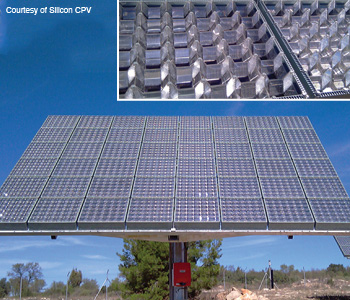 Silicon CPV is commercially producing and installing 120× and 4× CPV systems, such as this 4× installation near Valencia, Spain in September 2010. A 960× product is due to go into production in April 2011. (Inset) The proprietary prismatic structure of the PMMA 120× concentrator "SiCon" lens from Silicon CPV refracts light to the central silicon cell.
Silicon CPV is commercially producing and installing 120× and 4× CPV systems, such as this 4× installation near Valencia, Spain in September 2010. A 960× product is due to go into production in April 2011. (Inset) The proprietary prismatic structure of the PMMA 120× concentrator "SiCon" lens from Silicon CPV refracts light to the central silicon cell.
Silicon CPV has also chosen a refractive concentrator design for its systems, featuring a prismatic structured lens made of injection-molded PMMA that focuses the light with 89.8 percent collection efficiency to a central silicon-based cell. Each lens is comprised of 81× precision prisms that focus light onto an area of 15 × 15 mm (see photo to the right).
According to CEO Humayun Maghal, Silicon CPV expects to offer a levelized cost of electricity (LCOE) of €0.11 ($0.15)/kW·hr in a sunny location such as Laayoune, Morocco, by 2012, well below that of any other major PV technology. The company plans further cost reductions that will bring the LCOE to €0.08 ($0.11)/kWh for locations with global horizontal irradiation of 2,200 kWh/m2/year.
SolFocus, another leading developer of CPV solar systems, announced in October that their CPV systems will be used to build the first commercial solar-power plant in Saudi Arabia. SolFocus CPV systems use a reflective design that includes a primary mirror to capture sunlight, along with a secondary mirror and a non-imaging optical system to concentrate sunlight 650 times onto high-efficiency III-V solar cells (see image below). The project, located in the Bahra region, will deliver around 300 MWh of clean energy per year and is the first in a series of planned Saudi solar-power stations.
The R&D of CPV
An interesting new direction in solar technology is planar concentrating photovoltaics. University of California, San Diego, U.S.A. (UCSD) graduate students Jason Karp, Justin Hallas and colleagues are researching solar concentrator designs that use a two-dimensional sheet of micro-optic lenses as a solar concentrator (see photo on opening page).
Each of the millimeter-sized lenses forms a small image of the sun, focused onto localized coupling mirrors fabricated onto a slab waveguide surface. The planar waveguide/lens-array captures sunlight from the thousands of small apertures and directs the energy along the length of the waveguide to a single photovoltaic cell mounted along the waveguide edge.
Placing localized coupling mechanisms at the focus of each lens element enables light from the entire lens array to be tilted past the critical angle of the slab and guided by total internal reflection. The planar micro-optic concentrator represents a new approach to solar concentration in that the geometry yields a thin, flat profile that can be fabricated by low-cost, high-volume batch or roll processing. This configuration opens a new design space for high-efficiency CPV systems with the potential for cost reduction in optics, assembly and tracking mechanics.
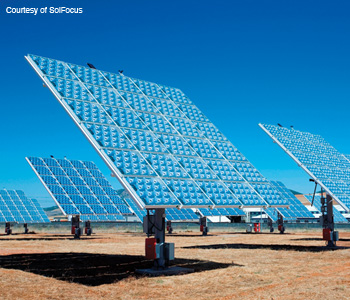 In 2008, SolFocus installed a 500-kW system at the Institute of Concentration Photovoltaic Systems in Puertollano and Almoguera, Castilla La Mancha, Spain. The installation features the SF-1000 reflective concentrated PV technology.
In 2008, SolFocus installed a 500-kW system at the Institute of Concentration Photovoltaic Systems in Puertollano and Almoguera, Castilla La Mancha, Spain. The installation features the SF-1000 reflective concentrated PV technology.
Simulations of the design achieved 90 percent optical efficiency at 73× concentration and 82 percent at 300×. The complete system efficiency incorporates the conversion efficiency of the solar cell, which can exceed 40 percent for multijunction solar cells (optical efficiency times conversion efficiency of the cell = system conversion efficiency). The team has published preliminary experimental results of a concentrator using self-aligned coupling prisms fabricated by exposing molded SU-8 photopolymer through the lens array.
The planar waveguide selected by UCSD maintains a constant 1-mm thickness, while most other designs in development rely upon wedged or tapered guides. Planar guides can be fabricated in large sections while tapered optics must be molded as smaller parts and assembled and aligned to create the whole system.
"Current commercial offerings occupy a large optical volume that must be assembled and mounted onto a large, two-axis tracking platform," says Karp. Segmenting the aperture into smaller individual lenses shrinks this volume, but typically increases complexity by requiring additional components and interconnects, according to Karp. "Our technology is designed to create an overall large aperture in a thin form factor without relying on small-scale assembly and alignment," he says. "In this way, we can build micro-optics onto large glass substrates using high-volume manufacturing techniques analogous to those used for flat-panel monitor production."
The main challenge in planar concentrators is providing high efficiency during propagation. Mechanisms used to couple light into the waveguide strip energy with every coupling feature downstream and its subsequent interaction with light. Designing the system so that coupling points occupy a very small fraction of the waveguide surface promotes total internal reflection and improves efficiency.
In the UCSD design, the initial focusing of the lens array mounted above the waveguide allows the coupling regions to occupy less than 1 percent of the surface. Propagation within the patterned waveguide inherently leads to some loss; however, concentrators with 500-mm-long apertures can still be optically efficient. Further increases in waveguide length add to the concentration ratio, but incur additional loss.
Karp points out that the lenses must be well aligned to the waveguide-coupling regions. "Our alignment solution molds the coupling feature into a photopolymer, which is cross-linked by UV exposure through the lens array," he says. "This approach fixes alignment between the two components during fabrication and is tolerant to imperfections because the actual lens focus is used as the lithography mask." The process is compatible with inexpensive roll-to-roll manufacture and may lead to large-aperture planar optics suitable for CPV applications.
Like all solar concentrators, the planar design only works on sunny days. "Traditional solar panels still produce some energy under overcast skies, but concentrators rely on the directionality of the sun to focus onto small PV cells," says Karp. This restriction limits their use to areas with high direct irradiance such as deserts in the southwestern United States. Yet with the right conditions, CPV systems deliver more power per unit area than any other solar technology. Although comparing technologies depends on how efficiency is measured, some currently available CPV panels (like that of SolFocus) reach approximately 25 percent conversion efficiency whereas the best silicon PV panels typically fall below 15–19 percent. The CPV industry hopes to use this advantage to lower the cost of electricity and gain market share.
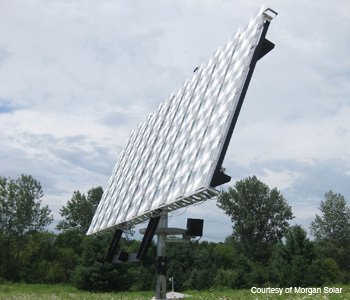 Morgan Solar is now testing a commercial planar CPV system in the field. The low-cost Sun Simba CPV system was installed at an in-field testing site in Ontario this August.
Morgan Solar is now testing a commercial planar CPV system in the field. The low-cost Sun Simba CPV system was installed at an in-field testing site in Ontario this August.
Another type of planar concentrator is the luminescent solar concentrator (LSC), which involves a luminescent plate made of plastic or glass coated with a dye that absorbs light and re-emits it to a waveguide. Like the UCSD design, the guided light is concentrated onto the edges, where solar cells are attached. No lenses or mirrors are used. In recent LSC research, Marc Baldo at the Massachusetts Institute of Technology (Cambridge, Mass., U.S.A.) and colleagues aligned the dye molecules with respect to the waveguide to allow for a larger fraction of the light to be coupled into the plate.
This approach increases the fraction of trapped light from approximately 65 percent to 80 percent. "I believe that this might be a new trapping efficiency record for regular glass, but imperfections in the alignment of the dyes leave a lot of room for improvement," says Baldo. "Pushing this efficiency higher is an important area of research, as is pushing the absorption of the dye into the infrared."
Planar comes to market
Several other research groups and start-up companies are pursuing planar CPV technologies. Although no commercial planar solar products are on the market yet, Morgan Solar in Toronto is close. Morgan Solar's first product to hit the market will be the Sun Simba, which uses thin, proprietary planar concentrating optics of acrylic and glass (see photo above). Like the one at UCSD, the design essentially eliminates the focal distance between the optic and the PV cell. Designed for ground-mounted solar farms, the Sun Simba is a high-efficiency panel that can be built at a fraction of the cost of existing CPV systems. The Simba is expected to hit the solar-farm market sometime in 2011.
Another company with a planar CPV product nearing commercial availability is Banyan Energy (Berkeley, Calif., U.S.A.). Shondip Ghosh, co-founder and CEO at Banyan, a startup that began in 2005, says that improving the optics was an obvious choice early on to make a difference in optimizing a PV system. "We found that a flat form factor would be a clean and elegant solution," says Ghosh. Using their own optical design software, they developed a proprietary technology called aggregated total internal reflection (ATIR), a new class of waveguide optics (see photo below).
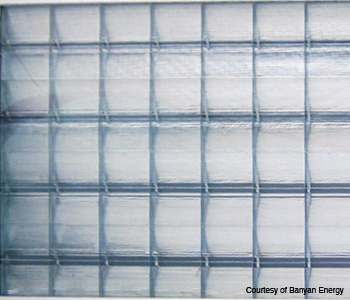 Banyan Energy's prototype CPV solar modules introduce an ATIR optics sheet on top that focuses light onto four vertical dark strips of crystalline-silicon PV cell material. The modules are comparable in area and depth to standard solar modules but enable 5 to 10 times more modules to be manufactured with existing solar cell manufacturing capability.
Banyan Energy's prototype CPV solar modules introduce an ATIR optics sheet on top that focuses light onto four vertical dark strips of crystalline-silicon PV cell material. The modules are comparable in area and depth to standard solar modules but enable 5 to 10 times more modules to be manufactured with existing solar cell manufacturing capability.
Like other planar CPV solutions, the ATIR optic is a flat sheet involving concentrating optics and waveguide elements that replace the cover glass in standard PV modules. ATIR enables delivery of any concentration, from low concentrations of 2×, to 10×, or to the highest 1,000× concentration. Another benefit of the waveguide approach is that the manufacturing and deployment process is easily assimilated by existing manufacturers and installers of standard PV modules. "If you can deliver something that looks, handles and feels like a standard module, it's more likely to be accepted and adopted," says Ghosh.
A lot of recent R&D and commercial effort is focused on multijunction solar cells, which can have conservation efficiencies of up to 40 percent, compared to c-Si at 20 percent. Originally developed for use in space applications, multijunction cells are pricey, so they require concentration ratios higher than 400× to be cost effective. "The sweet spot for concentration on c-Si is 5–10×," says Ghosh.
For multijunction cells, it is 1,000×, he says, because they're so expensive. "This is why we decided to focus on c-Si, which only requires concentration between 5–10× to make it cost effective. The more highly concentrated the light must be, the more expensive the technology, including the tracking mechanics as the field of view is reduced." For Banyan, it made sense to go with an approach that builds on and improves the existing manufacturing base for the industry, taking on lower technical risk and increasing their rate of adoption.
Banyan's business approach is to partner with major solar manufactures that use tried-and-true c-Si technology that has already reached GigaWatt-scale operation. "We plan to integrate ATIR technology with the solar modules of manufacturers with established fabrication operations, capital, brand and market access," says Ghosh. "For the leading solar manufacturers, we can dramatically reduce their module costs while increasing the scale of module production 5-10 times that of existing solar cell capacity." Banyan is currently testing prototypes, and he expects to move into first production in late 2011.
The next big step for CPV technology is to improve the reliability and lifetime of the components. "Any solar technology solution needs to provide a 25-year warranty to make the economics work," says Ghosh. "Any new technology, be it thin-film or an optics solution, has to go through the process of validation and proving reliability." Industry standard testing, set by UL, IEC and TUV, might include temperature and humidity cycling in a chamber from -40° C to 85° C, and thermal conditioning for 1,000 hours at 85° C with high humidity.
"Success in solar is driven by the ability to deliver a low LCOE, such that our customers can bid with competitive power prices," says Amonix chief executive Brian Robertson. "Also, a strong history of performance and reliability is critical to the banks that finance these projects. Banks and utilities are adopting CPV for larger projects in desert areas because it works. Although other types of solar projects have been announced, for the last three years, 100 percent of actual field deployments in the United States have been PV-based." Robertson estimates that around 1 GW of PV will be deployed in 2010. "I like all solar, but I believe the market is skewing towards PV, with CPV growing significantly in market share over the next few years."
Valerie C. Coffey is a science and technology writer and editor based in Boxborough, Mass., U.S.A.
References and Resources
>> S. Kurtz. "Opportunities and Challenges for Development of a Mature Concentrating Photovoltaic Power Industry," report from the National Renewable Energy Lab (2010).
>> SolFocus.com, "Primer on CPV Technology" (2008).
>> H. Mughal. An Innovative Design of a Low Cost 1203 Concentrating System Based on One Sun Technologies," 34th IEEE Photovoltaic Specialists Conference, Philadelphia, PA (7-12 June, 2009).
>> B. Unger. Opt. Photon. News 20(9), 26 (2009).
>> J. Deign. CPV Today, "Is CPV poised for mainstream?" (2010).
>> J. Hallas et al. "Lateral translation micro-tracking of planar micro-optic solar concentrator," Proc. SPIE 7769, 776904 (2010).
>> J. Karp et al. Opt. Express 18, 1122 (2010).
>> C. Mulder et al. Energy Express 18, A91 (2010).
>> G. Overton. Laser Focus World 46, 50 (2010).
